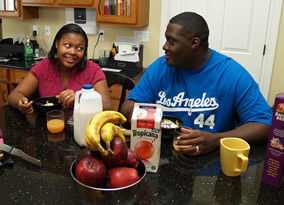Food does more than satisfy hunger; it provides fuel for the body and mind, too. So as you make a list of school supplies to buy for the upcoming school year, don’t forget to consider the items at your local supermarket that can also help prepare your child for the classroom.
Catherine Kraus, RD, M.Ed, CHES, a dietitian at the University of Michigan Health System, says that a balanced, healthy diet enables chemical messengers in the brain — known as neurotransmitters — to function more efficiently. This produces better concentration and memory.
Parents can take several steps to create well-balanced meals and snacks that provide children the energy and nutrition they need to perform well at school, notes Kraus, a member of the Pediatric Comprehensive Weight Management Center at U-M C.S. Mott Children’s Hospital.
Breakfast. Research has demonstrated that students who skip breakfast in the morning don’t perform as well as students who do eat breakfast. Kraus recommends serving a healthy breakfast that consists of a whole grain cereal, oatmeal or bread with a form of protein, such as peanut butter or a hard-boiled egg.
Pairing the meal with whole fruit instead of a fruit juice offers a way to add more vitamins, minerals and fiber into a diet. Kraus adds that dairy products are an acceptable addition to your child’s breakfast, as long as they are in the form of fat-free or low-fat milk, yogurt or cheese.
Lunch. While many schools are making efforts to include healthier items on lunch menus, high-calorie items still exist — including pizza, nachos and sweetened drinks. If you are concerned about your child’s cafeteria choices, Kraus recommends packing a lunch.
“When children consume a high-fat, high-sugar meal, their bodies will crash, and they will be come very tired and lethargic — which is not going to help them perform at their best level in school,” explains Kraus.
When packing a lunch, variety is best; choose an assortment of fruits and vegetables in various colors and sizes. This ensures that kids receive a mix of vitamins and minerals, and it will prevent them from becoming bored with the same packed lunch routine every day. Kraus recommends including a type of whole grain product in the meal, such as tortillas or bread, with a lean protein, such as tuna, turkey or chicken.
She also notes that sweetened beverages are full of empty calories and don’t provide any nutritional value. Opt for a beverage that does not contain added sugars — such as water, fat-free or low-fat milk, or 100 percent fruit juice.
Snacks. When it comes to snack foods, Kraus says that the proper adage to follow is, “Out of sight, out of mind.”
“When you are grocery shopping, keep in mind that if a snack is in the home, your children will likely eat it. So keep healthy food in the house at all times to ensure that they will always have healthy snack options. If you keep candy bars and fruit in the home, most children would pick the candy bar. So just keep it out of the house,” she says.
Focus on finding snack foods that will keep your kids satisfied until dinner and energized for homework and studying. For optimal energy and hunger satisfaction, Kraus recommends pairing protein with a high fiber carbohydrate; serve up string cheese or peanut butter with whole grain crackers or prepare a half-sandwich made with whole grain bread or pita. Another tasty treat option is creating a homemade smoothie by blending yogurt and fruit together.
She also suggests that parents take time each day to wash and slice fresh fruits and vegetables. Remember to place the produce on the counter or at eye level in the refrigerator so it is more accessible to children.
Dinner. “A smart dinner will help your child’s brain function. If they are satisfied after dinnertime then they will sleep through the night, and a child needs at least eight to nine hours of sleep a night in order to function while in school the next day,” explains Kraus.
She says that half of a “smart” dinner plate should be made up of fruits and vegetables, and a quarter of the plate should consist of a lean protein. Fill the remaining quarter with whole grains, such as brown rice or whole wheat pasta.
Overall Kraus says that encouraging your children to eat smart during the school day can help them develop healthy habits for life.
“Childhood is a crucial time when bodies are growing and brains are developing,” she says. “It’s so important to fuel the body with good nutrition, and teaching children smart eating habits at a young age is a great idea. It starts with the parents serving as the role model.”
For more information on healthy eating for kids, visit these Web sites:
UMHS Your Child: Feeding Your Child and Teen
http://www.med.umich.edu/1libr/yourchild/feed.htm
Centers for Disease Control and Prevention: Healthy Youth! Nutrition Guidelines
http://www.cdc.gov/HealthyYouth/nutrition/guidelines/help.htm
KidsHealth.org: School Lunches
http://kidshealth.org/parent/nutrition_fit/nutrition/lunch.html
Source: Unversity of Michigan via Newswise

